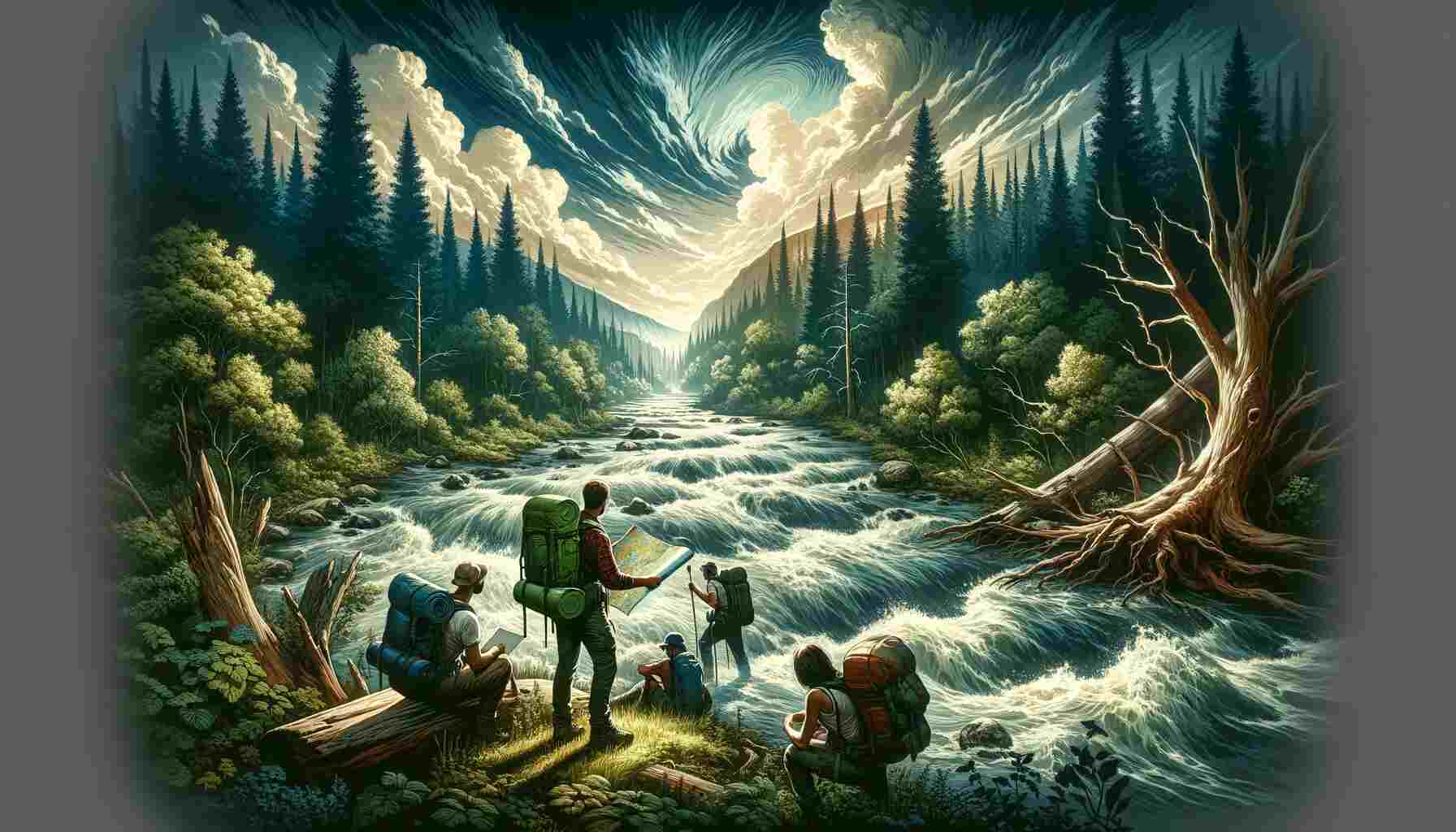As our world grapples with the acceleration of climate change, outdoor enthusiasts in the United States face a growing threat – flash floods. This article is your trusted companion on a journey to understand the risks associated with flash floods and to equip you with the knowledge to keep your outdoor adventures safe and enjoyable.
Understanding Flash Floods
Picture this: You’re out in the wilderness, exploring the great outdoors when, suddenly, a torrent of water rushes through. This is a flash flood – a sudden and intense flooding event, often triggered by heavy rainfall. Unlike regular floods, flash floods strike within minutes or hours of rain, offering little time for preparation. Recent climate studies, including those reported by ScienceDaily, have sounded the alarm about the increasing frequency of flash floods across most of the U.S.
Flash floods are nature’s way of reminding us of her immense power. They can turn a tranquil stream into a raging torrent in the blink of an eye, catching even the most seasoned adventurers off guard. To embark on your outdoor escapades with confidence, it’s vital to grasp the nature of flash floods and how best to prepare for them.
Safety First: Preparing for Flash Floods
Preparation is the name of the game when it comes to outdoor safety. Here’s a checklist of essential steps to ensure you’re ready:
- Check the Weather Forecast: Before you lace up those hiking boots or pack your camping gear, always check the weather forecast. Pay special attention to flash flood warnings or watches in your area. Apps and websites like the National Weather Service and Weather.com are your go-to sources for up-to-the-minute weather updates.
- Carry an Emergency Kit: Every outdoor enthusiast should have an emergency kit on hand. Think of it as your trusty sidekick in the wilderness. This kit should include first-aid supplies, non-perishable food, water, a flashlight, a multi-tool, and a portable phone charger. You’ll thank yourself for having these items in case of an unexpected twist in your adventure.
- Know Your Evacuation Routes: Familiarize yourself with evacuation routes in the area you plan to explore. Understanding how to reach higher ground swiftly can make all the difference in an emergency. This knowledge becomes your lifeline, especially when you find yourself in unfamiliar territory.
- Recognize Early Signs: Flash floods often provide early warning signs that, if spotted, can be life-saving. Keep your senses sharp for these indicators:
- Rapidly rising water levels in streams, rivers, or arroyos.
- Unusual and intense sounds from water, like a roaring or rushing noise.
- Debris floating downstream.
- Mudslides or rockfalls in hilly terrain, which can signal heavy rainfall upstream.
Impact on Outdoor Recreation
The allure of outdoor activities like hiking and camping is undeniable, but they are not without their share of challenges, especially when it comes to flash floods. Here’s what you need to keep in mind:
- Trail Conditions: Flash floods can wreak havoc on hiking trails, rendering them impassable and treacherous. Always check with local authorities or park rangers for trail conditions before setting out. If a trail is marked as unsafe due to flash flood risk or is temporarily closed, respect the warning.
- Campsite Selection: When choosing a camping spot near water bodies, take into account the risk of flash floods. Opt for elevated campsites away from riverbanks or low-lying areas. Stay vigilant and be ready to relocate if conditions change suddenly.
- Stay Informed: Before embarking on any outdoor adventure, stay informed about local flood warnings and weather conditions. Many national and state parks provide real-time updates through visitor centers or websites. Ignorance is not bliss when it comes to your safety.
Technological Advances in Flood Prediction and Management
Advancements in technology have opened up new avenues for flood prediction and management, offering outdoor enthusiasts like you valuable tools to stay safe. One such tool is FEMA’s Integrated Public Alert & Warning System (IPAWS), designed to provide timely alerts about various emergencies, including flash floods. Here’s how technology can be your ally:
- Mobile Apps: A multitude of mobile apps can deliver real-time weather alerts and flood warnings tailored to your location. Popular apps include NOAA Weather, AccuWeather, and The Weather Channel. These apps put vital information at your fingertips, ensuring you stay in the know.
- Emergency Alerts: Most smartphones are equipped to receive emergency alerts from government agencies. Ensure that your phone settings permit these alerts, as they can provide life-saving information during flash flood events.
- GPS and Mapping Services: GPS and mapping services, like Google Maps, come to your aid when you’re navigating unfamiliar terrain. These tools can help you identify higher ground and evacuation routes, crucial for your safety during a flood.
Climate Change and Increasing Flood Risks
The rising frequency of flash floods is a direct result of climate change. As temperatures climb, so does the risk of heavy rainfall events. ScienceDaily’s research underscores the growing dangers, emphasizing the need for environmental awareness within outdoor communities.
Here’s how climate change plays a role in flash floods:
- Increased Intensity of Rainfall: Warmer air can hold more moisture, leading to heavier and more intense rainfall. This surplus of water can rapidly overwhelm river systems, triggering flash floods.
- Altered Weather Patterns: Climate change can disrupt established weather patterns, resulting in unpredictable and extreme weather events. These shifts can make flash floods both more frequent and more severe.
- Melting Glaciers: In some regions, the melting of glaciers contributes to increased water flow into rivers and streams. This can exacerbate flash flood risks, particularly in mountainous areas.
Real-Life Stories and Case Studies
Real-life stories of flash flood encounters offer invaluable insights into the dangers and necessary precautions. These stories serve as a reminder of the unpredictable and awe-inspiring power of nature. Let’s delve into a few of these cases:
- Zion National Park, Utah: The canyons of Zion National Park are known for their stunning beauty, but they also harbor the risk of flash floods. In 2015, tragedy struck when a group of hikers was caught in a flash flood in Keyhole Canyon, resulting in fatalities. This heartbreaking event serves as a poignant reminder of the dangers and the imperative need for careful planning when exploring such areas.
- Havasu Falls, Arizona: Havasu Falls is a magnet for hikers and campers, boasting its turquoise waters. However, Havasu Canyon is no stranger to flash floods. In 2008, a flash flood hit the area, causing significant damage to campsites and hiking trails. Visitors must remain vigilant and stay informed about weather conditions to be prepared to evacuate if necessary.
- Big Thompson Canyon, Colorado: The Big Thompson Canyon has witnessed devastating flash floods in the past, most notably in 1976. This event led to numerous casualties and substantial property damage. Since then, the community has taken steps to improve flood preparedness and warning systems.
These real-life stories underscore the importance of heeding warnings, staying informed, and being prepared when venturing into areas prone to flash floods. Nature’s power is breathtaking, but it can also be perilous when not treated with respect.
Community and Government Initiatives
FEMA and local governments are actively working to mitigate flood risks through community engagement and resilience programs. These initiatives aim to educate the public about flood preparedness and response. Here’s what you need to know:
- Community Outreach: FEMA and local emergency management agencies organize outreach programs to educate residents and outdoor enthusiasts about flood risks. Workshops, seminars, and training sessions on preparedness are often on the agenda.
- Floodplain Management: Many communities implement floodplain management strategies to reduce the impact of flash floods. This includes zoning regulations, land-use planning, and infrastructure improvements.
- Early Warning Systems: The development of early warning systems, such as sirens and automated alerts, plays a pivotal role in notifying residents and visitors about impending flash floods.
- Floodplain Mapping: Accurate floodplain maps help communities understand their flood risk and plan accordingly. FEMA provides flood hazard mapping to support local planning efforts.
Conclusion
The growing threat of flash floods is a challenge that outdoor enthusiasts must take seriously. By staying informed, prepared, and vigilant, adventurers can continue to safely enjoy the great outdoors. Here are your key takeaways:
- Always check the weather forecast and be mindful of flash flood warnings.
- Keep an emergency kit handy, packed with essential supplies.
- Familiarize yourself with evacuation routes in your chosen area.
- Train yourself to recognize early signs of flash floods and act promptly.
- Stay well-informed about local flood warnings and trail conditions.
- Show respect for park closures and warnings, even if they disrupt your plans.
Ultimately, outdoor enthusiasts have a responsibility to themselves and their fellow adventurers to prioritize safety and make well-informed decisions. As we navigate the rising tide of flash flood risks, let’s do so with reverence for nature and a commitment to preserving the beauty and wonder of the outdoors for future generations.
Additional Resources
For more in-depth information and updates, don’t forget to visit FEMA’s website (https://www.fema.gov/) and other relevant resources. Staying informed and prepared is your strongest defense against the unpredictable forces of nature. So, venture forth, explore the great outdoors, and enjoy your adventures safely and responsibly.








